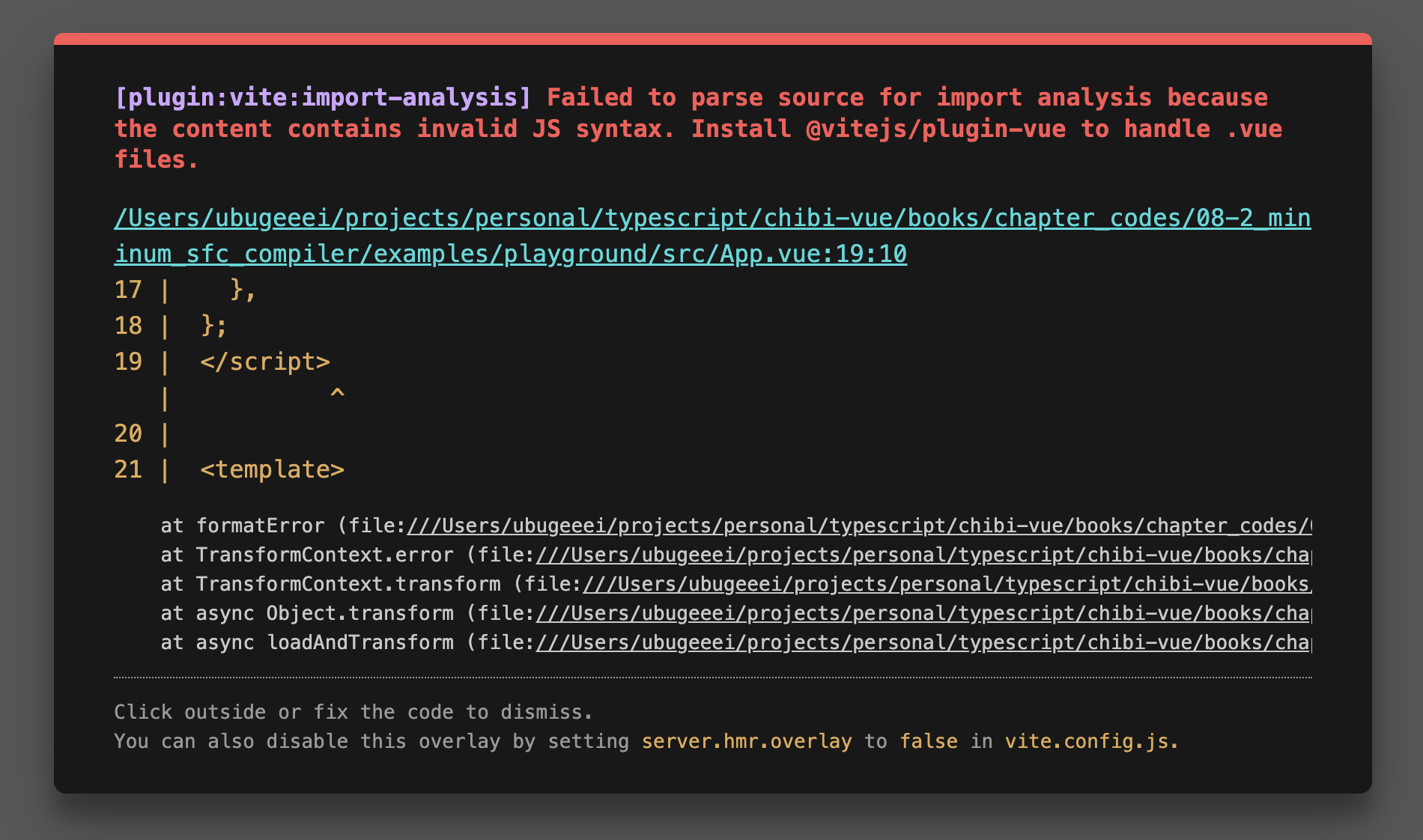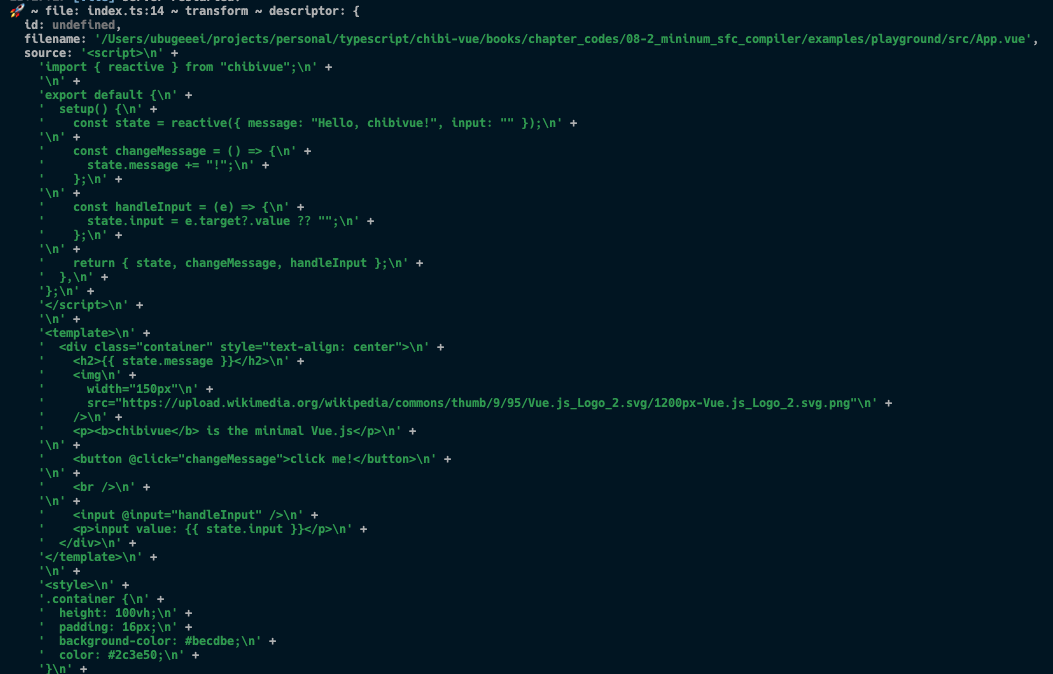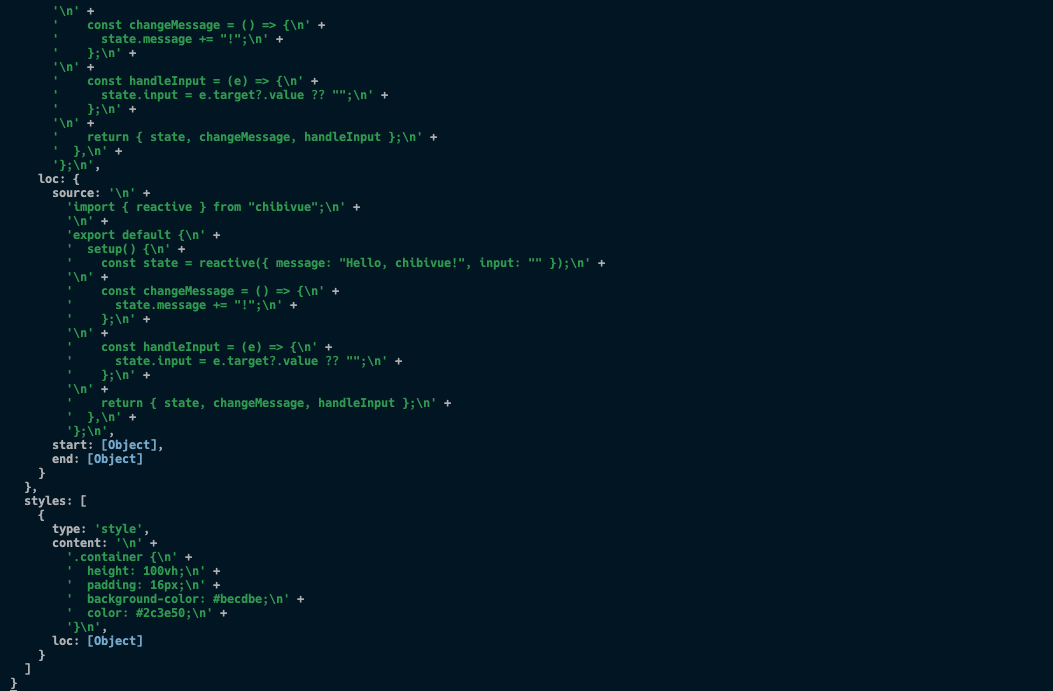实现 SFC 解析器
准备工作
虽然这是我们之前创建的示例插件,但让我们删除它,因为它不再需要了.
pwd # ~
rm -rf ./plugin-sample另外,为了创建 Vite 插件,请安装主要的 Vite 包.
pwd # ~
ni vite这是插件的主要部分,但由于这原本超出了 vuejs/core 的范围,我们将在 packages 目录中创建一个名为 @extensions 的目录并在那里实现它.
pwd # ~
mkdir -p packages/@extensions/vite-plugin-chibivue
touch packages/@extensions/vite-plugin-chibivue/index.ts~/packages/@extensions/vite-plugin-chibivue/index.ts
import type { Plugin } from 'vite'
export default function vitePluginChibivue(): Plugin {
return {
name: 'vite:chibivue',
transform(code, id) {
return { code }
},
}
}现在,让我们实现 SFC 编译器.
但是,没有任何实质内容可能很难想象,所以让我们实现一个游乐场并在运行时进行.
我们将创建一个简单的 SFC 并加载它.
pwd # ~
touch examples/playground/src/App.vueexamples/playground/src/App.vue
<script>
import { reactive } from 'chibivue'
export default {
setup() {
const state = reactive({ message: 'Hello, chibivue!', input: '' })
const changeMessage = () => {
state.message += '!'
}
const handleInput = e => {
state.input = e.target?.value ?? ''
}
return { state, changeMessage, handleInput }
},
}
</script>
<template>
<div class="container" style="text-align: center">
<h2>{{ state.message }}</h2>
<img
width="150px"
src="https://upload.wikimedia.org/wikipedia/commons/thumb/9/95/Vue.js_Logo_2.svg/1200px-Vue.js_Logo_2.svg.png"
alt="Vue.js Logo"
/>
<p><b>chibivue</b> is the minimal Vue.js</p>
<button @click="changeMessage">click me!</button>
<br />
<label>
Input Data
<input @input="handleInput" />
</label>
<p>input value: {{ state.input }}</p>
</div>
</template>
<style>
.container {
height: 100vh;
padding: 16px;
background-color: #becdbe;
color: #2c3e50;
}
</style>playground/src/main.ts
import { createApp } from 'chibivue'
import App from './App.vue'
const app = createApp(App)
app.mount('#app')playground/vite.config.js
import path from 'node:path'
import { fileURLToPath } from 'node:url'
import { defineConfig } from 'vite'
import chibivue from '../../packages/@extensions/vite-plugin-chibivue'
const dirname = path.dirname(fileURLToPath(new URL(import.meta.url)))
export default defineConfig({
resolve: {
alias: {
chibivue: path.resolve(dirname, '../../packages'),
},
},
plugins: [chibivue()],
})让我们尝试在这种状态下启动.

当然,这会导致错误.做得好(?).
解决错误
让我们暂时解决错误.我们不会立即追求完美.
首先,让我们将 transform 的目标限制为 "*.vue".
我们可以像在示例中那样使用 id 编写分支语句,但由于 Vite 提供了一个名为 createFilter 的函数,让我们使用它创建一个过滤器.
(这没有特别的原因.)
~/packages/@extensions/vite-plugin-chibivue/index.ts
import type { Plugin } from 'vite'
import { createFilter } from 'vite'
export default function vitePluginChibivue(): Plugin {
const filter = createFilter(/\.vue$/)
return {
name: 'vite:chibivue',
transform(code, id) {
if (!filter(id)) return
return { code: `export default {}` }
},
}
}我们创建了一个过滤器,如果是 Vue 文件,则将文件内容转换为 export default {}.
错误应该消失,屏幕应该不显示任何内容.
在 compiler-sfc 上实现解析器
现在,这只是一个临时解决方案,所以让我们实现一个合适的解决方案.
vite-plugin 的作用是使用 Vite 启用转换,所以解析和编译在主 Vue 包中.
那就是 compiler-sfc 目录.
https://github.com/vuejs/core/blob/main/.github/contributing.md#package-dependencies
SFC 编译器对于 Vite 和 Webpack 都是相同的.
核心实现在 compiler-sfc 中.
让我们创建 compiler-sfc.
pwd # ~
mkdir packages/compiler-sfc
touch packages/compiler-sfc/index.ts在 SFC 编译中,SFC 由一个名为 SFCDescriptor 的对象表示.
touch packages/compiler-sfc/parse.tspackages/compiler-sfc/parse.ts
import { SourceLocation } from '../compiler-core'
export interface SFCDescriptor {
id: string
filename: string
source: string
template: SFCTemplateBlock | null
script: SFCScriptBlock | null
styles: SFCStyleBlock[]
}
export interface SFCBlock {
type: string
content: string
loc: SourceLocation
}
export interface SFCTemplateBlock extends SFCBlock {
type: 'template'
}
export interface SFCScriptBlock extends SFCBlock {
type: 'script'
}
export declare interface SFCStyleBlock extends SFCBlock {
type: 'style'
}嗯,没有什么特别困难的.
它只是一个表示 SFC 信息的对象.
在 packages/compiler-sfc/parse.ts 中,我们将把 SFC 文件(字符串)解析为 SFCDescriptor.
你们中的一些人可能在想,"什么?你在模板解析器上如此努力工作,现在你要创建另一个解析器...?这很麻烦."但不要担心.
我们在这里要实现的解析器并不是什么大事.那是因为我们只是通过结合我们迄今为止创建的内容来分离模板,脚本和样式.
首先,作为准备,导出我们之前创建的模板解析器.
~/packages/compiler-dom/index.ts
import { baseCompile, baseParse } from '../compiler-core'
export function compile(template: string) {
return baseCompile(template)
}
// 导出解析器
export function parse(template: string) {
return baseParse(template)
}在 compiler-sfc 端保留这些接口.
pwd # ~
touch packages/compiler-sfc/compileTemplate.ts~/packages/compiler-sfc/compileTemplate.ts
import { TemplateChildNode } from '../compiler-core'
export interface TemplateCompiler {
compile(template: string): string
parse(template: string): { children: TemplateChildNode[] }
}然后,只需实现解析器.
packages/compiler-sfc/parse.ts
import { ElementNode, NodeTypes, SourceLocation } from '../compiler-core'
import * as CompilerDOM from '../compiler-dom'
import { TemplateCompiler } from './compileTemplate'
export interface SFCParseOptions {
filename?: string
sourceRoot?: string
compiler?: TemplateCompiler
}
export interface SFCParseResult {
descriptor: SFCDescriptor
}
export const DEFAULT_FILENAME = 'anonymous.vue'
export function parse(
source: string,
{ filename = DEFAULT_FILENAME, compiler = CompilerDOM }: SFCParseOptions = {},
): SFCParseResult {
const descriptor: SFCDescriptor = {
id: undefined!,
filename,
source,
template: null,
script: null,
styles: [],
}
const ast = compiler.parse(source)
ast.children.forEach(node => {
if (node.type !== NodeTypes.ELEMENT) return
switch (node.tag) {
case 'template': {
descriptor.template = createBlock(node, source) as SFCTemplateBlock
break
}
case 'script': {
const scriptBlock = createBlock(node, source) as SFCScriptBlock
descriptor.script = scriptBlock
break
}
case 'style': {
descriptor.styles.push(createBlock(node, source) as SFCStyleBlock)
break
}
default: {
break
}
}
})
return { descriptor }
}
function createBlock(node: ElementNode, source: string): SFCBlock {
const type = node.tag
let { start, end } = node.loc
start = node.children[0].loc.start
end = node.children[node.children.length - 1].loc.end
const content = source.slice(start.offset, end.offset)
const loc = { source: content, start, end }
const block: SFCBlock = { type, content, loc }
return block
}我认为对于到目前为止已经实现了解析器的每个人来说都很容易.让我们在插件中实际解析 SFC.
~/packages/@extensions/vite-plugin-chibivue/index.ts
import { parse } from '../../compiler-sfc'
export default function vitePluginChibivue(): Plugin {
//.
//.
//.
return {
//.
//.
//.
transform(code, id) {
if (!filter(id)) return
const { descriptor } = parse(code, { filename: id })
console.log(
'🚀 ~ file: index.ts:14 ~ transform ~ descriptor:',
descriptor,
)
return { code: `export default {}` }
},
}
}这段代码在 Vite 运行的进程中运行,这意味着它在 Node 中执行,所以我认为控制台输出会显示在终端中.

/_ 为简洁起见省略 _/

看起来解析成功了.做得好!
到此为止的源代码: chibivue (GitHub)
